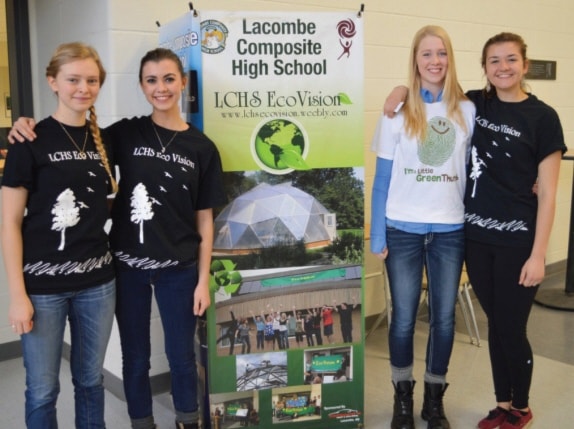With an emphasis on enhancing the environment and providing fresh food for the community, a group of Lacombe Composite High School (LCHS) students are taking positive steps towards water conservation.
The LCHS students in the school club EcoVision have just that, a positive environmental vision, which shows their willingness to commit to being stewards of the future.
Close to 40 members of the Red Deer River Watershed Alliance (RDRWA) joined four EcoVision members through a tour of the school on the morning of Jan. 16th, to showcase their past projects and to learn about their newest project, LEAFS, the Lacombe Educational Aquaponics Food System.
EcoVision was formed eight years ago.
The student lead club is assisted by LCHS Instructor Steve Schultz. The group consists of 25 to 30 students, who aim to become ecological leaders by implementing a variety of projects.
Over the years, the group has started a cardboard recycling program and a composting program, both within the school, as well as having installed a 6.0 kilowatt solar panel array that helps offset electrical costs.
The main project the group took on over two years ago is the geodesic dome community greenhouse, which truly enhances not only the school environment, but also the surrounding community.
The construction of the greenhouse was a true school-wide effort with students from all walks of life and programs contributing to the building, especially the fabrication students who took three weeks to build the structure and the foods program students, who on a daily basis, look after the plants that are grown inside.
The dome is a zero-energy, four seasons greenhouse, meaning it is self-sufficient and does not rely on external power. During the summer months, the community group Friends of Our Greenhouse (FOG) looks after the plants.
The food produced inside the greenhouse is used in the school cafeteria as well as being sold outside the school to the Lacombe community through the local food supplier The Green Pantry.
Expanding on the idea of providing fresh, local and sustainable food, and protecting the watershed, is the LEAFS project.
The project was conceived this school year and is being spearheaded by approximately 12 students, including Grade 11 leaders Ava Funkhouser, Janaya Fischer, Sofia Capettini and Michaela Reitsma. The group meets twice a week outside regular class time, once during flex time and once during lunch break.
For the average person, aquaponics is a daunting term, but for one of the LEAFS leaders Sofia Capettini, it can be summed up in one sentence.
“It’s fish and plants working together,” she effortlessly explained.
The LEAFS project is being brought to life inside the one-of-a-kind geodesic dome located on the west side of the school grounds.
Upon entering the ‘dome’ you are immediately struck by the humidity (the temperature is kept at a balmy 15C year-round) the amount of greenery (tropical plants, lemon trees and herbs) and the sky-high construct of barrels and spouts, which is the still-under-construction LEAFS project.
Through the system, tilapia, a type of fish, will be grown and harvested, along with leafy green plants, like basil, spinach and lettuce, all to provide food for the school and community.
By growing fish and plants together, food will be locally produced, which will reduce greenhouse gas emissions while reusing the water from the fish tanks to water the plants in the greenhouse. One of the aims of the project is to eliminate up to 70% of water waste, through the use of recycled water. Before the water is placed on the plants, it will go through three steps of filtration.
The fish take on average four to six months to reach the harvest ready stage, so the group plans to stagger the ages of the fish, in order to regularly supply the cafeteria with fresh fish. Each barrel in the greenhouse can hold around 100 fish.
The food that is grown but not used by the school cafeteria will be, much like the current vegetables and plants that are grown in the greenhouse, marketed out to The Green Pantry and also to two local grocery stores.
Although the project is still in the construction phase, and has some kinks to work through, the leaders have been attending conferences to gather design ideas and will be attending another in the future to point their project in the right direction.
The group anticipates the LEAFS system will be up and running fully by next fall.
Since its inception, the EcoVision club, with a constantly evolving group of students, has received many environmental awards including a prestigious Emerald Award as well as winning the 2014 Central Alberta Caring For Our Watershed Competition.
Before the tour this past Friday, the club was presented with an OTIS Award, which recognizes businesses, individuals and youth who are outstanding stewards within the Battle River Watershed.
As Lacombe sits right in the middle of the Battle River and Red Deer River watersheds, overseeing the protection and care of the region is critical for future generations.
“Water is a resource that is incredibly important to all aspects of life,” said Ava Funkhouser. “If you are protecting it [the watershed] then you are protecting your society and your life. An environmental stewardship role is really important to our school, our project and should be important to everyone.”
Earth Works farm, located near Alix, also was presented with a RDRWSA Ambassador Award during the tour.
